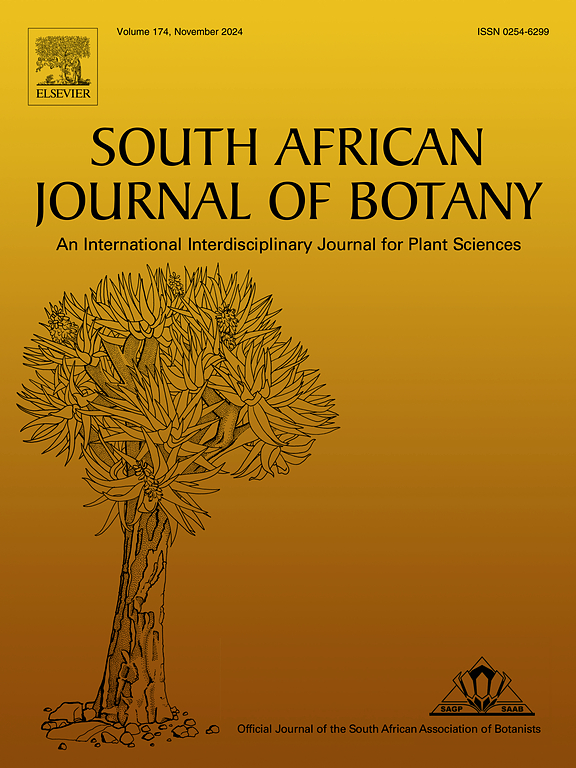选定药用植物提取物的生物活性化合物和抗氧化活性的比较分析:减轻肥胖相关炎症的意义
IF 2.7
3区 生物学
Q2 PLANT SCIENCES
引用次数: 0
摘要
肥胖是一种代谢紊乱,会导致各种健康并发症,包括糖尿病、高血压和心血管功能障碍。越来越多地使用植物提取物来降低肥胖风险,反映了消费者对自然疗法的偏好,以及对其安全性和有效性的科学验证。本研究分析了梅威拉(Merwilla plumbea)叶和根甲醇提取物中的生物活性化合物。鱼类,秋合欢(Mill.)Chitt,和Pentanisia prunelloides (Klotzsch) Walp。目的是探索和比较不同植物部分的药用特性,以减轻肥胖引起的炎症。叶和根中酚类物质含量分别为123.92 mg/mL和110.01 mg/mL,黄酮含量分别为44.4 mg/mL和55.05 mg/mL。萱草根中没食子丹素含量显著高于萱草根(5.19 mg/mL),而prunelloides根中原花青素含量显著高于萱草根(35.77 mg/mL)。通过铁还原抗氧化电位(FRAP)和DPPH自由基清除活性(RSA)测定其抗氧化活性。枯草根具有较高的FRAP (2.97 mg/mL)和中等的DPPH (RSA)(52.89%),而毛竹根具有最高的DPPH RSA(80.86%)和较低的FRAP (2.25 mg/mL)。秋菖蒲根和叶的FRAP分别为2.78和2.13 mg/mL, DPPH RSA分别为80.72和74.54%。结果表明,在所调查的所有植物中均含有相当数量的生物活性化合物,其中prunelelloides含量最高,表明其具有进一步药用和营养开发的潜力。进一步研究验证关键化合物在体内的生物活性,探索季节变化,评估最佳采收方法对这些药用植物的可持续利用至关重要。本文章由计算机程序翻译,如有差异,请以英文原文为准。

Comparative profiling of bioactive compounds and antioxidant activity of extracts from selected medicinal plants: Implications for mitigating obesity-related inflammation
Obesity is a metabolic disorder, contributing to various health complications, including diabetes, hypertension, and cardiovascular dysfunction. Increased use of plant extracts to reduce obesity risk reflects consumer preference for natural remedies and scientific validation for their safety and efficacy. This study profiled bioactive compounds in methanolic extracts from the leaves and roots of Merwilla plumbea (Lindl.) Speta, Hypoxis hemerocallidea Fisch, Eucomis autumnalis (Mill.) Chitt, and Pentanisia prunelloides (Klotzsch) Walp. The objective was to explore and compare the medicinal properties of distinct plant parts for their potential to mitigate obesity-induced inflammation. P. prunelloides leaves and roots had higher concentrations of phenolics (123.92 mg/mL and 110.01 mg/mL) and flavonoids (44.4 mg/mL and 55.05 mg/mL), respectively. Gallotannins were significantly higher in H. hemerocallidea roots (5.19 mg/mL) while proanthocyanidins were predominantly found in P. prunelloides roots (35.77 mg/mL). The antioxidant activity was assessed by ferric reducing antioxidant potential (FRAP) and DPPH radical scavenging activity (RSA) assays. P. prunelloides roots had higher FRAP (2.97 mg/mL) and moderate DPPH (RSA) (52.89 %) while M. plumbea roots had the highest DPPH RSA (80.86 %) and lower FRAP (2.25 mg/mL). E. autumnalis roots and leaves showed FRAP values of 2.78 and 2.13 mg/mL, and DPPH RSA of 80.72 and 74.54 %, respectively. The results revealed that all plants investigated had considerable amounts of bioactive compounds with P. prunelloides showing the highest concentration, highlighting its potential for further pharmaceutical and nutraceutical exploration. Further research validating the bioactivity of key compounds in vivo, exploring seasonal variations, and assessing optimal harvesting practices is paramount for the sustainable utilization of these medicinal plants.
求助全文
通过发布文献求助,成功后即可免费获取论文全文。
去求助
来源期刊

South African Journal of Botany
生物-植物科学
CiteScore
5.20
自引率
9.70%
发文量
709
审稿时长
61 days
期刊介绍:
The South African Journal of Botany publishes original papers that deal with the classification, biodiversity, morphology, physiology, molecular biology, ecology, biotechnology, ethnobotany and other botanically related aspects of species that are of importance to southern Africa. Manuscripts dealing with significant new findings on other species of the world and general botanical principles will also be considered and are encouraged.
 求助内容:
求助内容: 应助结果提醒方式:
应助结果提醒方式:


